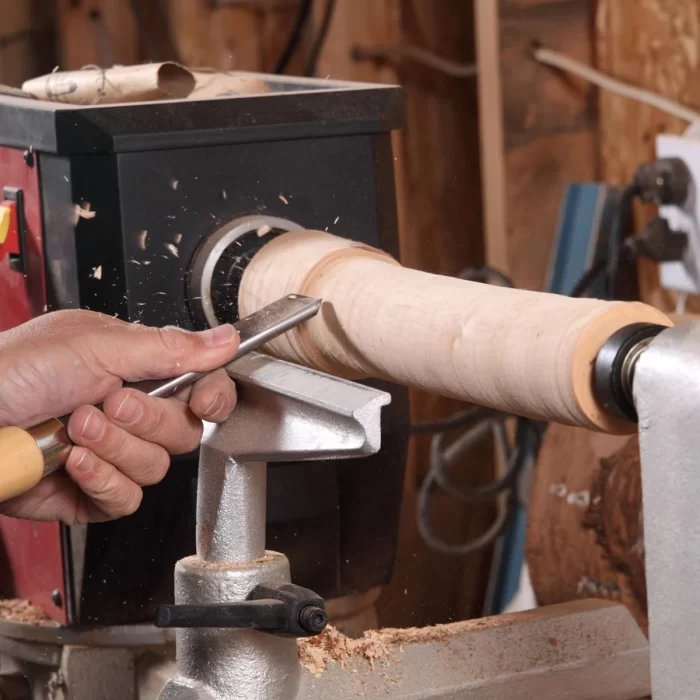Wood lathes are essential tools for any woodworking shop. They allow woodworkers to create a wide variety of turned wood objects like bowls, spindles, pens, chess pieces, baseball bats, chair legs, and more. Lathes rotate the wood while the woodworker holds cutting tools against it to shape it. In this article we talk about What are the Benefits of Wood Lathes in Woodworking?
Precision
One of the biggest advantages of a wood lathe is the precision it allows. The spinning action of the lathe combined with sharp cutting tools gives woodworkers very fine control over the shaping process. Cuts and details can be made with tight tolerances thanks to the mechanical nature of the spinning workpiece. This level of precision is difficult to match with hand tools alone when turning wood.
Consistency
A wood lathe also offers exceptional consistency. Once the right speeds and feed rates are dialed in according to the wood type and moisture level, the lathe can produce very consistent cuts. The machinery controls the spinning action so that each piece is turned at the ideal rate for clean and efficient material removal. This consistency is vital for turning multiples of the same shape and size.
Versatility
Wood lathes are extremely versatile tools. The same basic lathe setup can produce tiny decorative spindles, large robust table legs, delicate ornamental hollow vessels, and everything in between. With a broad assortment of chisels and gouges, the creative woodturner has the full capability to shape wood into countless forms, limited only by imagination and skill. Advanced woodturners can even add attachments like bed extensions, duplicators, and more to further increase what projects are possible.
Accessibility
While advanced professional-level wood lathes exist, there are also many entry-level and mid-range lathe models at accessible price points for all budgets. Variable speed settings on modern wood lathes allow both beginners and professionals to adjust the optimum turning speed for their comfort level. Easy-to-use lathes make it possible for woodworkers of all skill levels to start turning. The smooth mechanical action of the spinning wood is also very forgiving and encourages a gentle learning curve.
Efficiency
Properly set up wood lathes spin the wood at ideal speeds for efficient cutting. The machinery eliminates the manual effort of carefully rotating irregular shaped wood. Powered mechanical spinning saves woodworkers significant time and energy they can instead invest directly into the shaping process. Lathes transform raw wood into turned forms with far less physical exertion compared to manual turning methods. This efficiency gain lets artisans focus solely on their craft.
Accuracy
The precisely aligned spinning action of wood lathe combined with sharp cutting tools results in very accurate turned forms. As craftspeople remove material, they can constantly check diameters and symmetries to produce highly accurate final objects. Calipers and curved templates make measurements easy without stopping the lathe. The accuracy possible simplifies the challenge of crafting multiples of the same item since each iteration can be made practically identical.
Safety
While any power tool demands focus and care, wood lathes have several advantages that actually enhance safety. The hand tools used for turning have simple rounded profiles with no sharp points or teeth. The spinning action of the lathe keeps the wood securely in place without the need to ever adjust grip. The free hand rests safely on the tool rest jig. Lathes completely avoid kickbacks. And the ability to start slowly and safely is ideal while developing muscle memory. With reasonable precautions and training, wood lathes enable very secure and controlled cutting.
Surface Quality
The fine finish possible with wood lathe tools rivals that of sandpaper alone. A sharp skew chisel can leave a glass-like polished finish directly off the tool. Other scrapers, gouges and specialty tools can leave exceptionally fair curves ready for fine sanding. The grain of the wood flows smoothly across the surface thanks to the curve of the cuts. Lathes give woodworkers the means to not just shape wood but also control the aesthetic appearance of the surface.
Creativity
Wood lathes are amazing tools for freeing creativity. They transform the craftsperson from struggling against wood into effortlessly gliding through wood. The momentum of all that spinning power alleviates much manual labor to shape the material. The hands guide the tools but the machine does the work. This creates the mental space for makers to tap into imagination. Grain patterns flow, colors emerge, forms take shape. At some point the spinning workpiece becomes a dancer, the tools become brushes, and a whole new world of artistry spins into view. This is the creativity unique to the wood lathe.
Fun!
It’s worth mentioning as well that wood lathes can simply be tremendously fun tools to operate. The combination of mechanical spinning power with sharp hand tools gives a unique sensation not found in other woodworking methods. Guiding a sharp tool to peel up a flowing ribbon of wood, watching patterns emerge from raw stock, and seeing a form take shape before your eyes is a genuinely fun and rewarding experience. Wood lathes invite experimentation and provide instant feedback. All this makes for an incredibly enjoyable hobby for all ages.
In summary, key benefits of incorporating a wood lathe into any woodworking shop include precision, consistency, versatility, accessibility, efficiency, accuracy, safety, surface quality, creativity encouragement, and fun. Wood lathes open doors to new projects and new skills. They require an investment upfront but pay back that investment many times over by enabling beautiful turned wood creations. From the simplest hobbyist to the most advanced professional turner, wood lathes are rewarding tools that give as much to the woodworker as the effort put into learning them. If you have yet tried turning, it’s an exciting world ready to be discovered. I sincerely hopy you find this “What are the Benefits of Wood Lathes in Woodworking?” article helpful.


